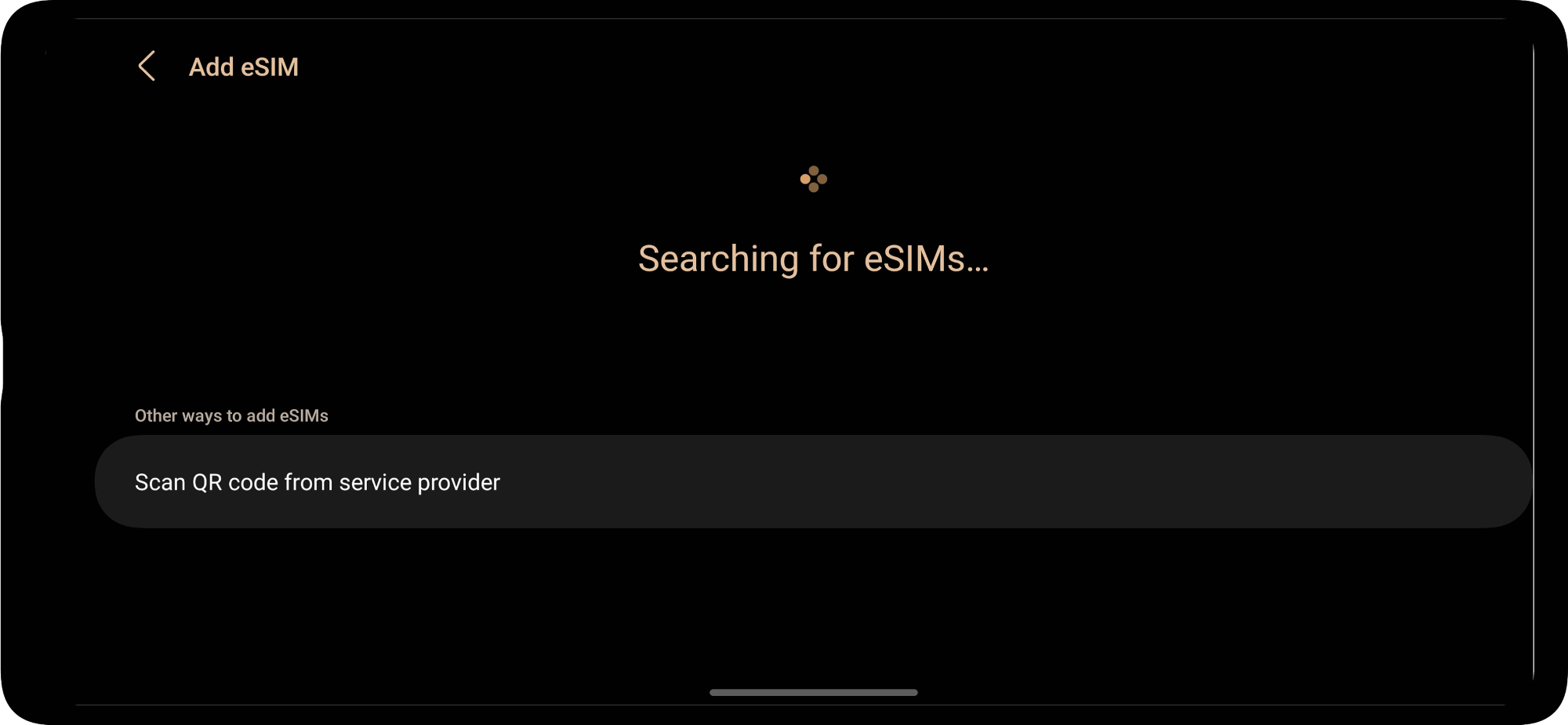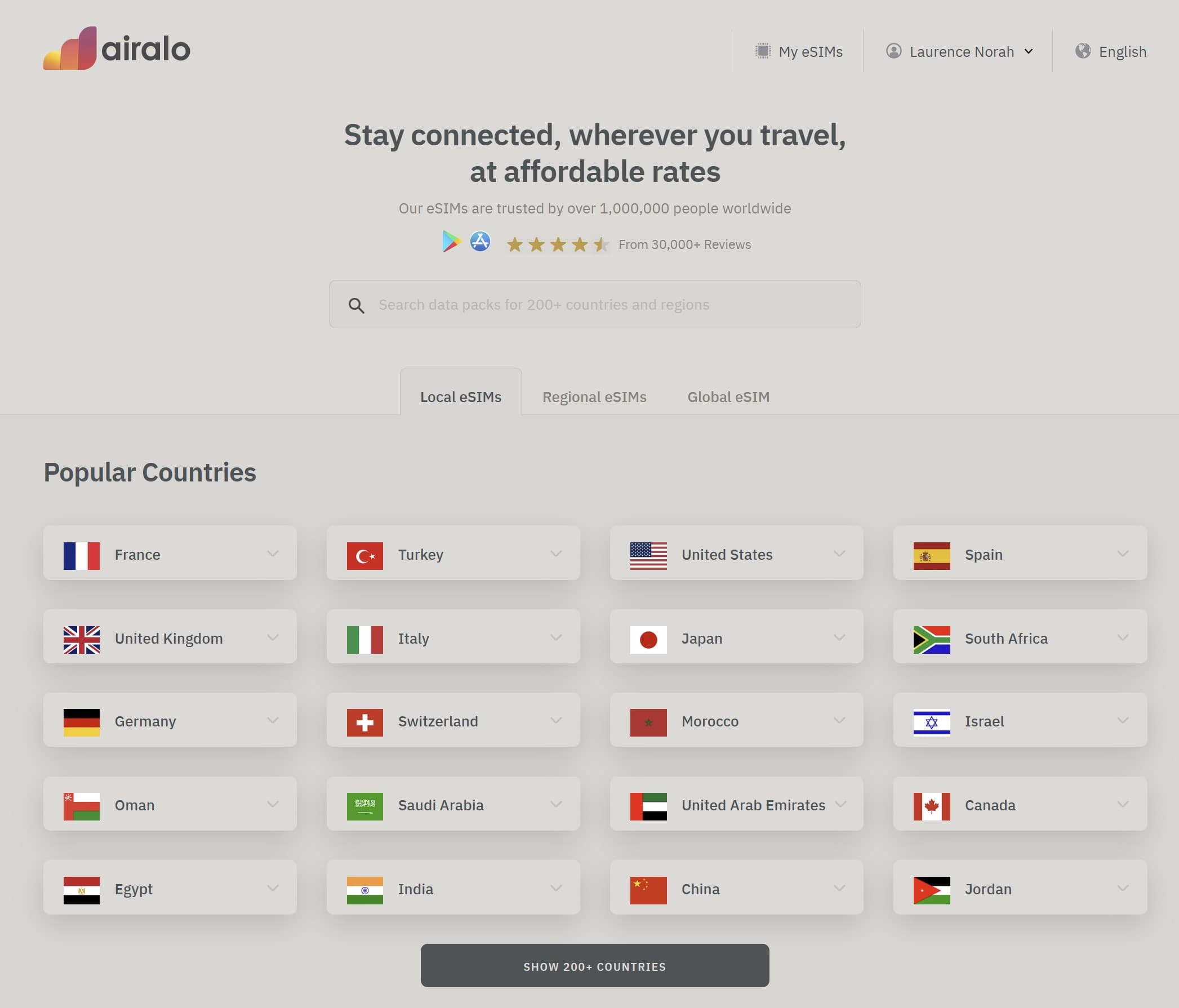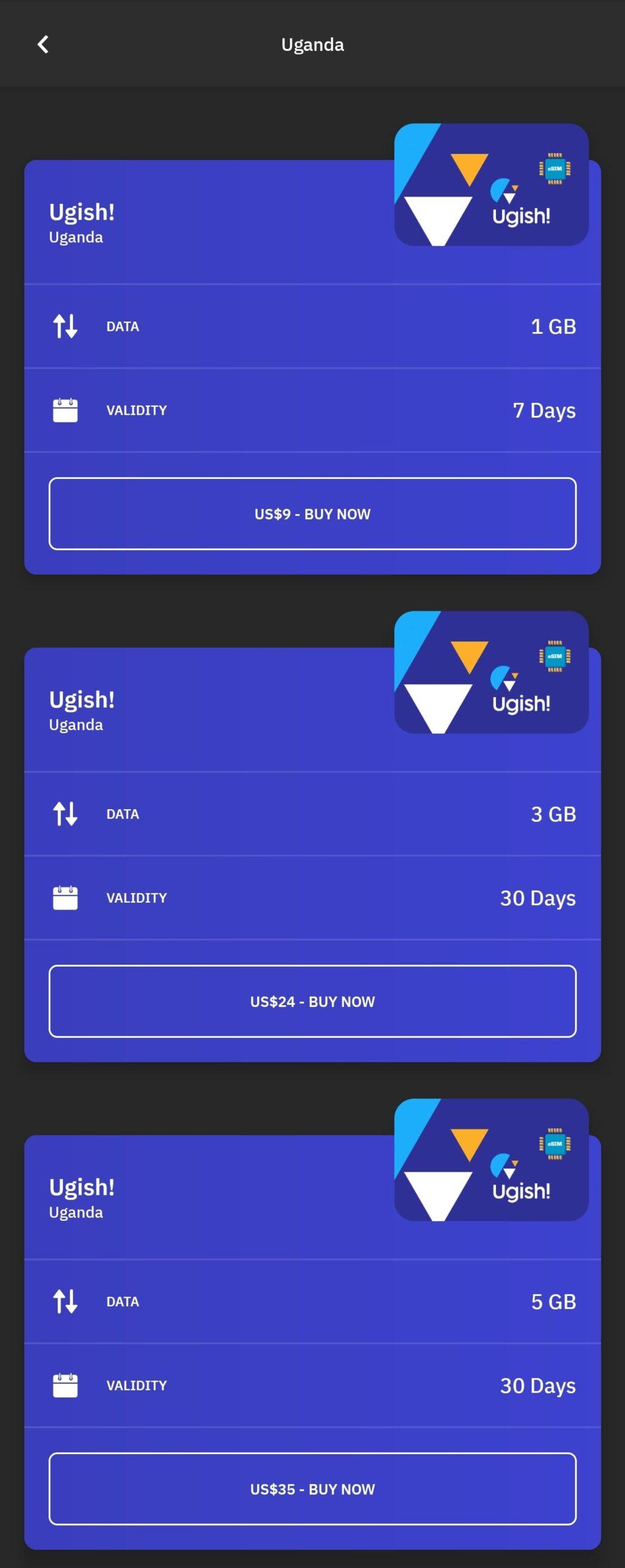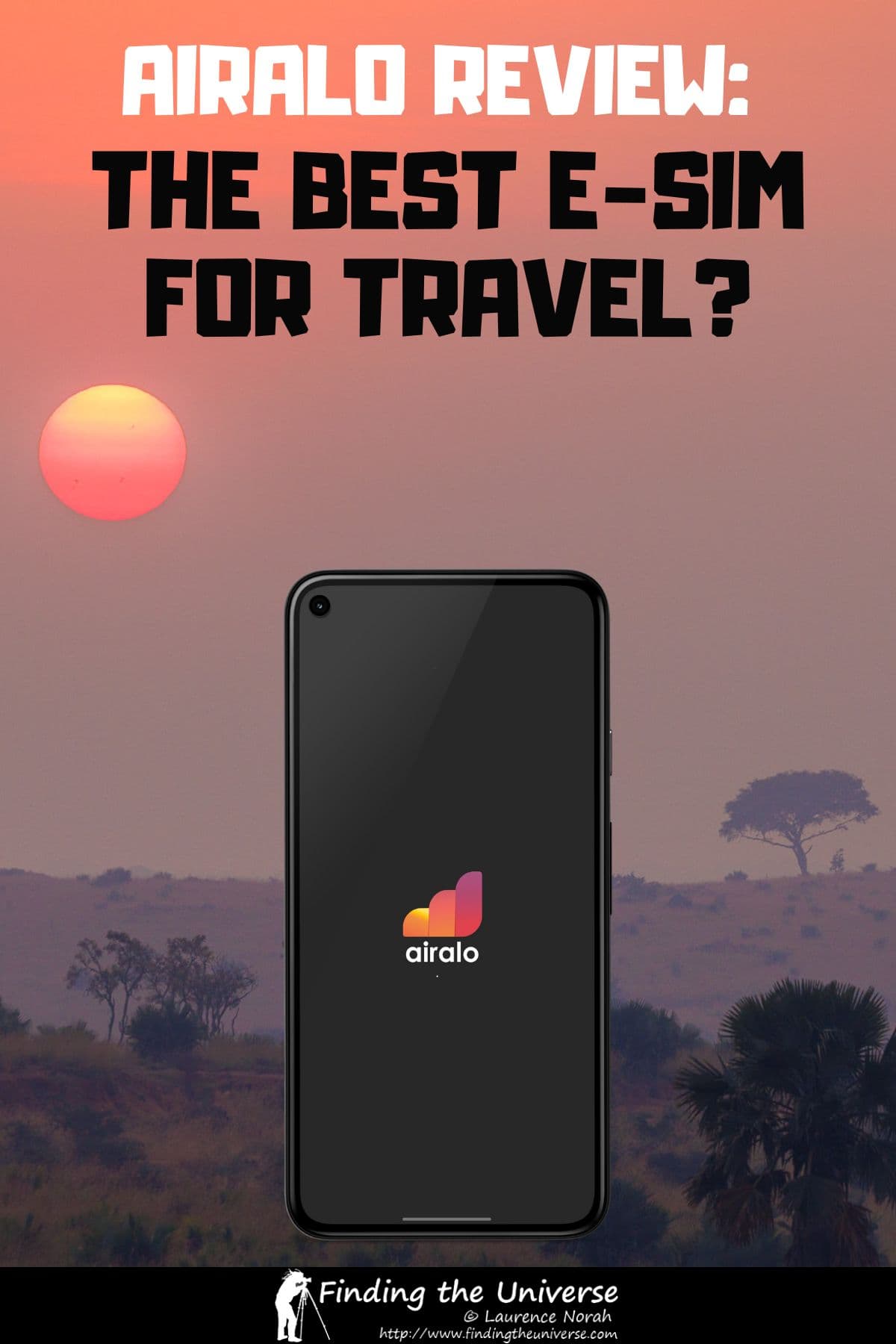If you’re planning on taking a trip, you might be wondering what is the best way to get online when traveling internationally? Well, we have tried many options, and one of those options is the eSIM provider Airalo.
In this guide, we’re going to provide a full review of the Airalo eSIM service to see if it might be the right option for you when travelling outside of your home country.
This will be based on our personal experience using an Airalo eSIM in a number of different countries around the world, as well as our expertise as long-term professional travelers who work on the road and need to be connected.
The Airalo eSIM is a great option, but it won’t be right for everyone. Let’s dive in and start with the basics.
What is an eSIM?
You are probably familiar with a SIM card. It’s the small bit of technology that sits inside our smartphone and allows us to connect to our mobile provider. It’s basically what uniquely identifies you as a subscriber to your mobile service and allows you to be able to make phone calls, send messages, and get online. SIM stands for Subscriber Identification Module.
SIM cards are not unique to smartphones. They can also be used in some laptops and tablets, as well as smart watches and mobile hotspots. In all devices, they serve the same function, which is to identify your device to your network provider and let you access the services you have paid for.
Traditionally, SIM cards have been physical products, consisting of a small bit of circuitry surrounded by plastic. Over time they have shrunk a bit, with sizes including standard SIM cards, micro SIM cards, and nano SIM cards. However, the general idea has remained the same. You get a SIM card from a mobile provider, you insert it in your phone and voila!, you are connected to the world.
eSIM technology is basically an evolution of the physical SIM card. The “e” in eSIM stands for embeddable. Basically, an eSIM is a programmable SIM card that is permanently installed inside the device. So instead of having a physical SIM card that you insert into your device, with an eSIM you can install the SIM card much as you would install an app.
eSIM technology started to roll out in 2016, with most recent smartphones including the technology. When Apple launched the iPhone 14 in the USA, it only supported eSIM, there was no physical SIM support at all. Going forward, this is likely to become a more common practice across manufacturers. For better or for worse, eSIMs are here to stay and the use of physical SIM cards is likely to decline.

Why do you need a Travel eSIM?
If you want to get online when you travel internationally, you have a number of options for how to do that. I cover this in detail in my guide to getting online when traveling.
In summary, your main options are to:
- Roam with your home network provider
- Buy a travel SIM / eSIM
- Buy a local SIM card
- Use a mobile hotspot
- Use free WiFi
The right option will depend on a number of factors, including the device you have, where you are travelling to, and how much time you need to spend on your device.
For example, if your network operator offers free roaming in the destination you are visiting, then that is likely going to be your best option. However, this isn’t that common, so you are likely going to want to investigate another option as international data roaming fees can be eye wateringly expensive.
In this case, you might consider either a travel specific SIM or buying a local SIM card. In many cases, buying a local SIM card if your phone is unlocked and supports the available options is going to be the most cost-effective option.
However, it can be quite complicated to find the right operator and deal, and if you are traveling to a destination where you will encounter a language barrier, setting up a foreign SIM can be a daunting task.
Enter the travel SIM / eSIM. These are specifically designed for travelers looking for an easy and relatively cost-effective way of getting online. For a long time the convenience of a travel SIM was somewhat offset by the fact that they were relatively expensive.
However, a number of companies have stepped forward to offer much more competitively priced travel SIMs and eSIMs. And one of those companies is Airalo.
Who are Airalo?
Launched in 2019, Airalo offers a one-stop shop for eSIMs. As of the time of writing, they offer eSIMs for over 200 countries around the world, allowing you to get online virtually anywhere you are likely to be travelling.
What Products do Airalo Offer?
Airalo sells a range of eSIMs. These are available in three categories based on your travel destinations:
- Local eSIMs. These cover one country, and are normally the most cost-effective option if you are only traveling to one or two countries on a trip
- Regional eSIMs. These cover a region, such as Europe, the Caribbean Islands, or Latin America. They can be handy if you have a trip covering multiple countries in a short period of time
- Global eSIM. The global eSIM allows you to connect in around 80 of the more popular countries covered by Airalo. It doesn’t cover every country though, so you will want to check exactly which countries are included if you are considering it.
As well as choosing the category you are interested in, you also need to choose the validity of the eSIM card and how much data it comes with. Airalo eSIMs are generally available for between 7 days and 30 days of validity, and with between 1GB and 20GB of data. This does vary by country though, with the Global SIM being available for up to 180 days.
Personally we find that we use around 1 – 2 GB of data a week when we travel. Normally this is more than enough for all our research, navigation, and communication needs.
If you plan to share a lot of videos or photos, or share your data connection with other devices (using it as a personal hotspot) then you might need more data. If you are only using it for occassional e-mail checking and a bit of social media, you might need a bit less data.
One thing to note is that the majority of Airalo eSIMs (and most travel eSIMs) do not offer any voice minutes. They only offer data. We normally don’t mind this as we normally communicate with WhatsApp when traveling. If we really need to make a call, we use Skype over data. But if you plan on making a lot of phone calls using voice minutes, Airalo might not be the best option for you.

How Much Does Airalo Cost?
The cost of Airalo varies greatly depending on where you are traveling in the world, and the cost of data in that destination. How much data you choose and the validity of the data package will also affect the price.
It is normally more cost-effective to buy more data for a longer period of time, although of course you should only buy what you need.
As a rough idea as of April 2023, some prices are as follows:
- $15 for 5GB of data valid for 30 days in the UK
- $20.50 for 3GB of data valid for 30 days in Tanzania
- $20 for 5GB of data valid for 30 days in 39 countries in Europe, including the UK, Spain, France, and Italy
- $16 for 5GB of data valid for 30 days in the USA
- $20 for 5GB of data valid for 30 days in 13 countries in Asia, including Thailand, Vietnam, Japan, China, and Cambodia
As you can see, prices are very reasonable for the most part. In our experience, the most expensive options are on the African continent.
In our experience and research, Airalo tends to be more cost effective than most other travel eSIMs. However, it is also worth pointing out that Airalo is normally slightly more expensive than buying a physical SIM card in a local destination, although it is generally a bit easier to set up and start using.
Experience Using Airalo: Our Airalo Review
We have used Airalo on a number of international trips so I will detail our experience using it on recent trips in Uganda and Rwanda as an example.
The first thing I had to do to get started with Airalo was to check my phone was compatible. At the time I was using a Google Pixel phone, which is compatible with eSIM technology. The next step was to install the Airalo app, which is available for both Android and Apple devices.
Once downloaded, I signed up to the Airalo service through the app which was a pretty simple process.
Now it was time to choose the eSIM. In my case I was travelling for around four weeks in Uganda. Most of the other eSIM providers I checked out didn’t even have Uganda as an option, so I was pleased to see that it was available as one of the countries to choose from.

There were three eSIM options for Uganda when I signed up, as you can see in the image above. These were a 7-day 1GB option for $7 USD, a 30-day 3GB option for $24 USD and a 30-day 5GB option for $35 USD. I decided that as we would likely have WiFi most of the time, the 3GB 30-day option would be fine for my needs.
I purchased the eSIM, at which point I was sent a confirmation e-mail which contained links to detailed instructions for how to actually install an eSIM. This was included both as a video tutorial and as step-by-step guides for Android which you can see here and iOS which you can see here.
I would definitely recommend reading through the guide to eSIM installation. It’s not exactly hard, but as it is likely going to be as new to you as it was to me, it’s worth making sure you get it right.
There are actually a few ways to install an eSIM, depending on your device. If you have an Apple smartphone, the easiest way is just to use the “direct method” as outlined here. Apple has made it really easy to install eSIMs, so it’s just a question of a couple of button presses and away you go.
If you have an Android device, like me, you’ll have to choose either the QR code option or the manual installation option. These are also both possible on iPhone if you prefer to make life a bit harder for yourself.
For the QR code install method, part of the process for installing the eSIM required me to scan the QR code using my phone. This can obviously present a bit of a tricky situation as the QR code will be on your phone screen, so you won’t be able to take a photo of it with your phone.
Personally, I opened the e-mail with the QR code on my laptop and took a photo of that with my phone. You can also save the QR code and print it out, or share it to a friend’s device and take a picture of it there.
If you can’t do any of the above, you can also set up the eSIM manually, which just requires following the fairly straightforward instructions.
I followed the install instructions, scanning the QR code as required, and within a couple of minutes I had an eSIM installed on my phone. This felt very futuristic, after years of adding and removing physical SIM cards!
The last step was to enable mobile data and configure the Access Point Name, or APN settings. This would activate the data package. If you happen to be configuring the eSIM prior to your trip, I’d advise waiting until you want to actually start using it to do this step to be sure you don’t actually activate it and start the validity period. It shouldn’t activate until it actually connects to the network in the destination country.
As I was already in Uganda and ready to go, I activated the mobile data, made sure my device was configured to use the eSIM for data rather than my primary SIM, and typed in the provided APN settings. Instructions for how to do this were all provided by Airalo so you don’t need to be an expert to figure it out.
Within thirty seconds I had cellular reception and 4G data. I used it for thirty days with no problems and the 3GB data package lasted well, with a bit left at the end of the trip. We travelled all over Uganda, and we had good reception in the majority of the country, except the most remote areas.
Once I had installed the eSIM, I could easily add data packages if I wanted to. I didn’t need to do this in Uganda, but on a subsequent trip in Rwanda I did need to top up. The good news is that topping up doesn’t require the re-installation of the eSIM, you can just buy a data package and add it to an existing eSIM.
In addition, if I return to Uganda, the eSIM is still on my phone. So I could reactivate it and add data without having to go through the setup process, assuming I don’t change phone in the meantime.
Following my positive experience in Uganda, I used Airalo in Rwanda which was just as straightforward. Here I used a bit more data as I was using my device for tethering as well, so I ended up using the easy top-up process as well to purchase a bit more data during our trip.
Overall, my experience with Airalo has been very positive. It only took a few minutes to setup, and once I had installed my first eSIM, eSIMs for other countries were a lot easier to install as I understood the process. It was a little more expensive than purchasing a local SIM card, but it was definitely super convenient.
I also liked that, on my phone at least, I could leave my actual SIM installed alongside my eSIM. So I could still recieve things like bank authentication messages on my main number whilst using my Airalo SIM for data. This was a lot more convenient than juggling SIM cards.
The main disadvantage compared to a normal local SIM other than cost for us was that the Airalo eSIM did not allow for phone calls or texts. This made it more difficult to make a few needed local calls but we were able to do so using Skype over 4G without problem.
Alternatives to Airalo
Airalo is definitely an eSIM provider to consider, but it is not the only option. As well as the other options you have for getting online when you travel, there are a number of other eSIM providers out there.
In our experience, Airalo tends to offer some of the most competitive prices and covers the most countries of the eSIM providers we are aware of. However, some of these other providers might suit you better depending on your needs.
- Nomad – this eSIM provider doesn’t cover as many countries as Airalo, but one thing it does offer is the option to buy a lot more data, including unlimited data options. So if you are a heavy data user, this is one to consider.
- Alosim – another eSIM provider. They also cover fewer countries but in some cases their prices are a bit more competitive than Airalo. So it is worth comparing depending on your destination.
Advantages of Airalo
There are a number of advantages to using Airalo as your travel SIM option.
First, compared to a lot of other travel focused SIM and eSIM solutions, we have found that Airalo tends to be one of the most cost-effective options on the market. It’s also generally cheaper than say renting a mobile hotspot for your trip, and you can share you Airalo data if your smartphone supports mobile hotspot functionality. Just be aware that something like a laptop computer will tend to use a lot more data than a mobile device.
The next reason to use Airalo is that it is relatively simple to install and setup. You can install the actual eSIM prior to your trip if you want, meaning you’ll be able to activate your package and get online as soon as you arrive in your destination country.
This saves you having to navigate your way through the maze of SIM providers in your destination country, and also saves you potentially having to navigate a SIM setup in a foreign language. Many local SIMs need to have funds added and a data pack activated, and the instructions for doing so are normally only available in the local language. Navigating an app or sequence of SMS messages in a foreign language can be a real challenge, especially where you need to hand over financial information to purchase a data pack.
Many countries also have quite strict controls in place around SIM card purchase, requiring you to provide ID when you buy a SIM. So Airalo can definitely be more convenient, and we have often opted to use it even when it is a little more expensive just because it’s so easy to do.
It’s also worth noting that some newer smartphones come without any SIM slot at all, meaning you have to use an eSIM. Not all mobile network operators around the world support eSIM technology yet, so the option to just use a local SIM might not even be an option for you, depending on your phone model.
The other nice thing about Airalo is that it just works. In my experience, once I activate the eSIM data package I am able to get online within a few seconds. For the majority of my travels I’ve had a good 4G signal with Airalo. The app makes it easier to track data usage and it’s also easy to purchase a top-up data pack for a SIM as well.
Finally, and this will depend on your phone, you can normally have an eSIM installed and active at the same time as a physical SIM. If you have accounts that send you text messages to your phone number for authentication purposes, like a bank card or bank account, being able to receive these whilst using the eSIM for data is really handy.
In the past using a local SIM I’ve had to juggle between the local SIM and my home SIM in order to receive banking authentication messages for example, which can be a real pain. So being able to keep my home SIM active at the same time as having an eSIM for data really alleviates that pain point.
Disadvantages of Airalo
The main downside of Airalo is the compatibility. To use the Airalo service, you need a phone which supports eSIM technology. Whilst this does cover most recent phones, and especially recent handsets from Google, Apple, and Samsung, many older smartphones do not support eSIM technology yet. In this situation, you simply can’t use Airalo.
Another disadvantage of Airalo is cost. In many cases, Airalo can work out to be more expensive than just buying a local SIM card and using that if your phone supports it. Of course, Airalo is normally more convenient as you don’t have to worry about finding a SIM card, finding the right deal, and trying to navigate any language barriers when it comes to setting up the SIM and using it.
It’s also worth noting that whilst Airalo eSIMs cover your data needs, the majority of them do not support voice calls or SMS messaging. You can use voice services like Skype over data, as well as Whatsapp, but if you think you will need to make and recieve a lot of local calls then a local SIM might be a better option.
Finally, eSIMs cannot be transferred between devices. This normally isn’t going to be an issue for most of us, but if you happen to travel with multiple smartphones and also happen to switch SIMs between them for some reason, this isn’t something you can do with an eSIM as they are locked to the device.
Airalo Review Summary
Airalo is a great option for travelers looking for an easy, fairly cost-effective way to get online when traveling internationally. It might not be quite as inexpensive yet as buying a local SIM, but in many countries, it is very close, and we think the benefits make it worth investigating.
We particularly like how we can use the eSIM alongside our home SIM so we can still receive messages, and how easy it is to set up. We also appreciate just how many countries Airalo is available in.
Of course, Airalo won’t work for everyone. Whilst it works on most devices, eSIM technology is not yet universally available on every device. For those of you looking for the most cost-effective option, buying a local SIM may still be the best option.
If you are interested in Airalo, you can go to their website here to learn more and check it out yourself.

Further Reading
And that sums up our review of Airalo as an eSIM provider for getting international internet access.
We’ve also got a lot of other resources you might find useful, including the following.
- We have a full guide to getting online when traveling internationally, which should help you decide which is the best option for you
- Depending on your travel plans, you might need a travel router. See our guide to travel routers to help you decide which is right for you.
- We also have a full guide to the best mobile hotspots for you to read if you are interested in one of these devices.
- Fast internet access at home is also important! See our guide to the best home wifi routers for improving your home internet speeds.
- Staying safe online when you travel is important. See our guide to the best travel VPNs for tips on keeping your personal data safe when you’re on the road.
- You’re going to need to power all your devices when you travel – see our guide to the best travel adapters
- If you are heading out onto the road and looking for a laptop to get some work done, see our guide to the best laptops for photo editing
- Thinking of buying a new camera? See our guide to the best cameras for travel
And that’s it! As always, if you have any feedback about the post, or questions for us, just pop them in the comments below and we’ll get back to you as soon as we can.

